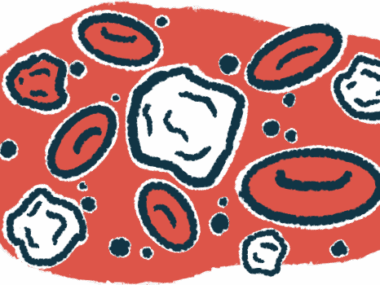CLR 131 Helps Heavily Treated Multiple Myeloma Patients, Phase 2 Data Show
Written by |

Cellectar Biosciences’ lead candidate CLR 131 safely and effectively prevents disease progression or reduces tumors in people with hard-to-treat multiple myeloma, according to data from a Phase 2 clinical trial.
The results also showed notable response rates to CLR 131 in people with a range of B-cell lymphomas who failed to respond or saw their disease progress after first responding to standard treatments.
“For patients who have failed the current standard of care treatments for any of these indications, there is a need for additional treatment options,” Sikander Ailawadhi, MD, an oncologist with the Mayo Clinic in Jacksonville, Florida, and the study’s lead study investigator, said in a press release.
“These results are even more impressive considering the challenging patient population tested, as all were heavily pre-treated, with the vast majority being refractory [failing to respond] to their most recent therapy,” said James Caruso, Cellectar Biosciences’ president and CEO.
CLR 131, a phospholipid drug conjugate, consists of CLR1404 — Cellectar’s small molecule that targets specific fat molecules, called phospholipid ethers (PLE), in the membrane of cancer cells — bound to a toxic, radioactive compound called iodine-131.
The therapy is designed to deliver radiation specifically to cancer cells and kill them, while limiting damage to healthy cells. It is being developed for the treatment of multiple myeloma and B-cell lymphomas, as well as pediatric and head and neck cancers.
The ongoing, open-label CLOVER-1 Phase 2 clinical trial (NCT02952508) was designed to evaluate CLR 131’s effectiveness in as many as 80 people with a range of pre-treated B-cell malignancies, including multiple myeloma, chronic lymphocytic leukemia/small lymphocytic lymphoma, lymphoplasmacytic lymphoma, marginal zone lymphoma, mantle cell lymphoma, and diffuse large B-cell lymphoma.
The trial is recruiting patients at about 10 U.S. cancer centers. Eligible multiple myeloma patients must have failed to respond to or relapsed after at least two prior lines of therapy, including proteasome inhibitors and immunomodulatory treatments.
Participants so far have received one of three different doses of CLR 131 — less than 50 mCi/m2, about 50 mCi/m2, and about 75 mCi/m2 in total — administered in either a single 30-minute session (given directly into the bloodstream) or two 30-minute sessions on day 1 and day 7.
The lowest dose was chosen as a sub-therapeutic dose, and participants in all dose groups have the option of receiving a second dose cycle 75 to 180 days later.
CLOVER-1’s main goal is to determine the proportion of patients achieving at least disease stabilization (clinical benefit) within three months following CLR 131’s first session. Secondary goals include overall response rate (partial and complete responses), the time patients live without signs of disease progression, and median overall survival.
The newly announced data cover 43 multiple myeloma patients, with a median age of 70, who had received a median of five prior treatment regimens. More than half (51%) were refractory to at least four treatment classes, and 44% to three classes. Ten of them received CLR 131’s lowest dose, 19 the intermediate dose, and 14 the highest dose.
The primary goal was met for this multiple myeloma group, with all patients achieving at least disease stabilization. Partial or complete responses were found in 42.8% of patients in the highest dose group and in 26.3% of those in the intermediate dose group, reflecting an overall response rate of 34.5% across all three dose groups.
Among patients receiving the highest dose, 85.7% showed tumor reduction, and partial or complete responses were observed in 50% of high-risk patients and 33% of those who were refractory to three therapy classes.
CLR 131 was well tolerated, with the most frequently reported adverse events being low levels of one or more types of blood cells. In the highest dose group, the most common severe adverse events were low levels of several types of blood cells, including platelets (65%), neutrophils (41%), lymphocytes (35%), white blood cells (30%), and red blood cells or hemoglobin (24%).
“CLR 131 offers a very attractive safety and efficacy profile,” said Ailawadhi.
Based on these positive results and additional data showing the potential to further improve response rates and durability, the study has been expanded to test a two-cycle dosing regimen. The optimized CLR 131 regimen comprises a total of four treatment sessions, given at day one and day 15, and again at day 57 and day 71.
The company believes CLR 131’s profile “can improve further with the administration of a second cycle,” and there are plans “to execute upon a well-defined and approvable regulatory path forward in a prioritized [blood-related] indication,” Caruso said.
“We hope that this potentially first-in-class PLE-targeted radiotherapeutic will provide a new and meaningful treatment option for patients living with multiple myeloma and/or [non-Hodgkin’s lymphoma],” he said.
The company also announced the completion of its Phase 1 clinical trial (NCT02278315), which tested escalating doses of CLR 131 in heavily pre-treated multiple myeloma patients. Based on the trial’s positive interim results, CLR 131 received orphan drug designation in both the U.S. and Europe, as well as fast track designation in the U.S. for the treatment of relapsed or refractory multiple myeloma.
These designations are meant to speed CLR 131’s development and review, as well as to provide regulatory support, financial benefits, and marketing exclusivity for a period of time upon approval (seven years in the U.S. and 10 years in Europe).






